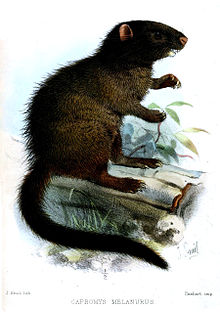

| Black-tailed hutia | |
|---|---|

| |
| Scientific classification | |
| Domain: | Eukaryota |
| Kingdom: | Animalia |
| Phylum: | Chordata |
| Class: | Mammalia |
| Order: | Rodentia |
| Family: | Echimyidae |
| Tribe: | Capromyini |
| Genus: | Mesocapromys |
| Species: |
M. melanurus
|
| Binomial name | |
| Mesocapromys melanurus (Poey, 1865) | |
| Synonyms | |
| |
The black-tailed hutia (Mesocapromys melanurus), also known as the bushy-tailed hutia, is a small, furry, rat-like mammal found only in Cuba. It lives in lowland moist forests and is threatened by habitat loss.[2] It is a member of the hutia subfamily (Capromyinae), a group of rodents native to the Caribbean that are mostly endangered or extinct.
Although it was formerly classified in the genus Mysateles, phylogenetic evidence supports it belonging to the genus Mesocapromys.[3]
|
Extant species of subfamily Capromyinae (Hutias) (formerly Capromyidae) in the family Echimyidae (Spiny rats)
| |||||||||||||||||
|---|---|---|---|---|---|---|---|---|---|---|---|---|---|---|---|---|---|
| |||||||||||||||||
| Echimyidae |
| ||||||||||||||||
| Mesocapromys melanurus |
|
|---|---|
| Mysateles melanurus |
|
| Capromys melanurus |
|
This article about a rodent is a stub. You can help Wikipedia by expanding it. |